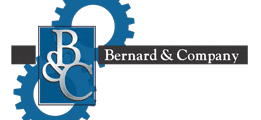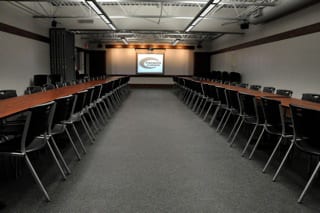Contact us today:
Author Archives: Bernard and Company
Heidelberg Foundry Amstetten Simulates Casting Processes with MAGMASOFT®
Simulation in action: casting quality, realizing innovation, reducing costs
The 1400 °C hot cast iron melt gushes through the gate into the mold. The movement of the flowing metal in the casting rigging and in the gradually filling mold for printing press cylinders and the subsequent solidification process are only chaotic and accidental, at first glance. The engineers of Amstetten Foundry, which forms part of Heidelberger Druckmaschinen AG, are familiar with every detail of the casting system. They ran through the entire process in advance with simulation software. This enables them to predict precisely what the quality and characteristics of the cast iron cylinder will be, when it leaves the mold and is finally integrated in a Heidelberg printing press.
The Amstetten factory is one of the most up-to-date and efficient foundries in all of Europe. It acts as a center of excellence for the manufacture of castings, such as printing press side panels or cylinders, for the entire Heidelberg Group, which has a yearly revenue of three billion euros (~$4.4 billion) and 15,000 employees. The parts are core elements of the sheet-fed offset presses that Heidelberger Druckmaschinen AG, as the market leader, provides to users in the print media industry worldwide. “For our customers, just like for ourselves, the decision for Heidelberg is always a decision for quality,” is how Jürgen Schimmel, Director of Pattern & Casting Engineering describes the company’s vision, which he implements on a daily basis together with the 450 employees involved in casting production. This is because the quality of the individual presses to a significant degree depends on the quality of the castings produced in Amstetten.
Amstetten’s staff does not just produce castings for the Heidelberg Group: 50 external companies order large and small castings in differing batch sizes from the Amstetten foundry. Free market competition does not just make economic sense; it also serves to ensure that all processes are focused on achieving the highest quality, according to Schimmel.
“We have a clearly defined goal: economical casting production with consistently high quality. We see casting as part of an overarching process, beginning in design and finishing in reliably functioning, competitive end products,” Jürgen Schimmel says when formulating the “mission” of the Amstetten foundry. This level of quality is achieved by continuous IT support over the entire production process – from design of the components and patterns to the stable computer controlled melting and pouring processes.
Casting simulation bridges the gap between design and production
The planning department Pattern and Casting Engineering bridges the gap between computer-aided product design and actual production using MAGMASOFT®, the leading software for simulating casting processes. In doing so, the engineers rely on a technology regarded in the industry as one of the most important innovations of the last 50 years. This is because casting process simulation opens up the possibility of taking a look inside the former “black box” of the mold, to understand and predict precisely what happens during pouring and solidification of the melt. As a result, the foundrymen are in a position to accurately characterize the casting and production process as well as predict the casting’s properties before production has begun. What this means in practice is that the engineers are in a position to develop a casting with defined qualities at their computers. Correct production parameters for the casting process, with which the casting can be produced economically and reliably, can be developed with calculable quality. Before simulation technology became available, the individual development steps had to be taken “by hand” – from the part design to its realization as a casting by means of numerous, expensive test castings – and at the end there was still no guarantee that the process would indeed be reliable enough for the casting to be produced in the defined quality.
Save on costs, implement innovations
The foundry of Heidelberger Druckmaschinen AG makes use of simulation technology throughout the entire product and process development process, in order to save materials and costs in a highly price-sensitive market on the one hand, and to drive innovation and optimize component integration on the other.
For example, so-called return scrap is saved by “riserless” casting. Since the melt contracts when it cools, like any material, additional metal usually has to be introduced into the mold via the risers in order to avoid defects / porosity – so-called shrinkage cavities – in the casting. Appropriate design of the casting process reduces return scrap and material consumption. Before making the investment decision for MAGMASOFT®, the foundry had calculated that using simulation return scrap could be reduced by eight percent – which would lower annual material costs by a six-digit euro figure. Additional cost savings accrue from optimization over the entire process. Thanks to the calculated cooling times, it is safe to run production at the fastest possible rate.
For instance, it was possible to greatly reduce shrinkage cavities during the manufacture of a chain guide by reducing riser volumes and altering the gating system. This not only resulted in a significant quality improvement, but also led to a reduction of €15.80 (~$22.75) per part in manufacturing costs, primarily from a reduction of approximately 2.5 kg in return scrap. Given an annual production of approximately 300 pieces, this comes to cost savings of around €4,700 (~$6,768).
Thanks to solidification simulation, it was possible to reduce the number of risers from 5 to 2 together with a 69 kg reduction in return scrap during production of a gear wheel, which lowered manufacturing costs per piece by €31 (~$44.65).
Simulation pioneer as technological partner
As its technology partner for simulation, Heidelberg Foundry relies on a pioneer in this methodology in MAGMA Gießereitechnologie GmbH, Aachen. In the late 1980s, MAGMA transformed casting simulation from university research to practical application. Ever since, the resulting software solution, MAGMASOFT®,® has set technical standards when it comes to simulating casting processes. It simulates mold filling, solidification and cooling during the casting process as well as mechanical properties, residual stresses and distortion of the castings created.
MAGMASOFT® consists of a basis package and a series of additional modules which cover all casting process production steps. They support the user starting from the design of the component, the selection of the melt treatment and casting layout, through pattern design and mold production to final heat treatment and finishing. The MAGMASOFT® application spectrum covers all cast materials, such as gray and ductile cast iron as used at the Heidelberg Foundry as well as aluminum and steel. Every casting process can be simulated with the software in order to design and assess the casting and tooling layouts, cycle times and casting quality.
Simulation software selection criteria
“User-friendly operation, short preparation time until start of calculations, realistic representation of results – those were the leading functional criteria when we chose MAGMASOFT®,” explains Hans Frieß, Director of Planning/Material Management. “And of course, another factor was the potential for future developments in the software.” But it was not just the software’s functionality and quality that were relevant to the decision. MAGMA itself as simulation pioneer was a factor. Hans Frieß puts it like this: “MAGMA established casting process simulation technology as a practical tool. The industry owes its trust in simulation primarily to MAGMA. The associated market and technological leadership and references were also persuasive when we were thinking about introducing a solution.”
Amortization in one year
In the meantime, cooperation in Amstetten with MAGMASOFT® and MAGMA has a track record of about eight years. The investment was amortized within just one year instead of two, as calculated prior to acquisition. The use of the simulation solution has resulted in faster component development, higher component quality and more economic production. The technology has also assisted the foundry in terms of innovation: using MAGMASOFT made it possible to begin manufacturing larger, heavier types of components.
Simulation marketing
The software also plays an important role in marketing and sales. When potential customers inquire about a particular casting, they are not only provided with a price, but also a pledge of reliable component quality and delivery times, based on simulation results. “Thanks to our use of MAGMASOFT®, we have actually acquired customers. When we made the investment decision this effect was one we had neither expected nor taken into account,” Hans Frieß is pleased to note. MAGMA now occupies a correspondingly prominent place in marketing as well: there are numerous casting simulation visualizations on the foundry’s website, shown as recognizable screenshots from the MAGMA software.
Simulation communication
And something else has undergone further development on the basis of the simulation software: communication with the casting designers and the foundry floor. The designers quickly get reliable feedback on whether a new component design is “castable”, while production gets reliable information on how to handle the casting process to achieve the best result. Conversely, based on the documented simulation results, both parties with their expertise can prepare creative solutions, which in turn can then be quickly and easily checked using simulation.
Simulation in the future – knowledge management and service orientation
“Using casting process simulation has now become indispensable for foundries,” Hans Frieß sums up. This was the only way for them to become service providers, taking on design and consultative activities and cooperating more closely with the companies using castings. Moreover, the software protects against know-how loss, since the knowledge is no longer just in the head of an expert but instead stored in a way that can be reused in MAGMASOFT®‘s databases. Consequently, the partnership between foundry and software will intensify further in the time to come – and continue on the basis of a new software generation, which will be launched shortly.
Picture material:
Solidification simulation of a MAGMASOFT®-optimized casting for a Heidelberg printing press (here: gear wheel). Riser optimization produced savings of almost € 40,000 (~$57,600) on this single part.
About software for casting process simulation
Casting process simulation software considers the complete casting process including mold filling, solidification and cooling, and also provides the quantitative prediction of mechanical properties, thermally induced casting stresses and the distortion of cast components. Simulation accurately describes a cast component’s quality upfront before production starts, thus the casting layout can be designed with respect to the required component properties. This results in a reduction in pre-production sampling, but also the precise layout of the complete casting system leads to energy, material and tooling savings for the foundry.
The range of application of MAGMA solutions comprises all cast alloys, from cast iron to aluminum sand casting, permanent mold and die casting up to large steel castings. The software supports the user in component design, the determination of melting practice and casting methodology through to mold making, heat treatment and finishing. This saves costs consequently along the entire casting manufacturing line.
During the last 10 years, the use of casting process simulation has become a valuable business asset for many foundries. MAGMA5 now expands the capabilities of casting process simulation and will further accelerate the acceptance of this technology.
About MAGMA
MAGMA offers comprehensive solutions to the metal casting industry, casting buyers and casting designers worldwide. The MAGMA product and service portfolio includes the powerful modular simulation software MAGMASOFT®,with the newest release MAGMA5, as well as engineering services for casting design and optimization.
Today, MAGMASOFT® is used throughout the metal casting industry, especially for the optimization of cast components in automotive and heavy industry applications.
MAGMA Giessereitechnologie GmbH was founded in 1988 and is headquartered in Aachen, Germany. A global presence and support are guaranteed by offices and subsidiaries in the USA, Singapore, Brazil, Korea, Turkey, India and China. Additionally, more than 30 qualified partners represent MAGMA around the world.
-0-
For more information on this release, please contact:
Christof Heisser
President
MAGMA Foundry Technologies, Inc.
10 N. Martingale Road, Suite 425
Schaumburg, IL 60173
Phone 847-969-1001 ext. 225
Email cheisser@magmasoft.com
Agency contact:
Tim Daro
Bernard & Company
847-934-4500
Continue readingForest City Gear Acquires Three New Haas Turning Centers to Produce “Donuts” for its Gearmaking Operations
FOREST CITY GEAR EXPANDS BLANKING DEPARTMENT
Leading gear manufacturer acquires three new Haas turning centers to produce “donuts” for its gearmaking operations

Forest City Gear’s blanking department now boasts a Haas ST-10 and two ST-20 Turning Centers. These machines were acquired recently to improve the throughput at Forest City Gear, a world leader in fine- and medium-pitch gear and spline work. The machines are used primarily for production of “donuts”, the near net blanks used in the company’s gearmaking operations.
Roscoe, IL-Forest City Gear has acquired three Haas turning centers to improve the throughput at its gearmaking facility. The company has made this investment, according to President Wendy Young, “…because we needed to better control our throughput and reduce the time to start up jobs. We were experiencing some severe delays from outside vendors and we saw problems on the horizon from such bottlenecks. Our company is always on the lookout for such conditions, because both our quality and our delivery protocols are vital to our success with current and potential customers in the world market.” These new machines will be used in the company’s Blanking Department, headed by Tommy Kalt, who detailed the new machines.
“We purchased a Haas ST-10 Turning Center with a magazine bar feeder, 300 PSI high-pressure coolant system and automatic tool presetter. It’s a fast, very flexible and very easy-to-use machine tool.” This machine, as well as two Haas ST-20 Turning Centers with 8” chuck and 20-station hybrid turret, fully programmable tailstock and high-pressure coolant pump, are currently operating in the Forest City Gear facility to produce “donuts” from automatically fed bar stock. These donuts are the near net shape blanks used in the gearmaking operation here. As a custom producer of extremely tight tolerance gears for the most demanding applications, according to company CEO Fred Young, “We need to have optimum control of our operation, at every step. Our company today exports gears to every corner of the world and our rigorous quality standards require a number of intermediate steps, prior to shipment. If the blanks are not available and our production is delayed, the entire operation slows and we simply will not allow that to happen,” Young stated emphatically.
Kalt expands on the ST-10. “It has a manual, programmable tailstock for shaft work, another real advantage in 
On the business side, Wendy Young was very satisfied with the cooperation of the Haas sales and delivery team. “We were treated fairly and the support has been first-rate, right from the start. We already see the benefits of this purchase to our company.”
For more information on this story, please contact: FOREST CITY GEAR CO., INC. 11715 Main Street Roscoe, IL 61073-0080 Phone: 815-623-2168 Fax: 815-623-6620 Web: www.forestcitygear.com
Email: wyoung@forestcitygear.com Attention: Wendy Young, President
PR agency contact for Forest City Gear: Tim Daro Bernard & Company 847-934-4500 tdaro@bernardandcompany.com
Continue readingGab from GIFA
Tim Daro
Continue reading350°F Floor Level Cabinet Oven
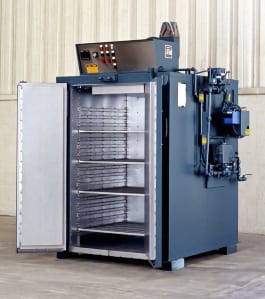
The oven has 4” insulated walls and a 750 CFM, 3/4-HP recirculating blower provides vertical airflow to the oven. Safety equipment, such as a 325 CFM, 1/3-HP powered force exhauster, is included as required by IRI, FM and the National Fire Protection Association Standard 86 for gas-heated equipment. The oven also features shelf supports on 3” vertical centers that are rated 200 lb. per level for a 1000 lb. maximum oven load.
Controls onboard No. 900 include a recirculating blower airflow safety switch, digital indicating temperature controller and a manual reset excess temperature controller with separate contactors.
For more information, please contact: THE GRIEVE CORPORATION, 500 Hart
Road, Round Lake, Illinois 60073-2835 USA. Phone: (847) 546-8225. Fax: (847) 546-
9210. Web: www.grievecorp.com. Email: sales@grievecorp.com. Attention: Frank Calabrese.
Agency Info: Tim Daro 847-934-4500
Continue readingHunter and Maus Have Successful GIFA Shows
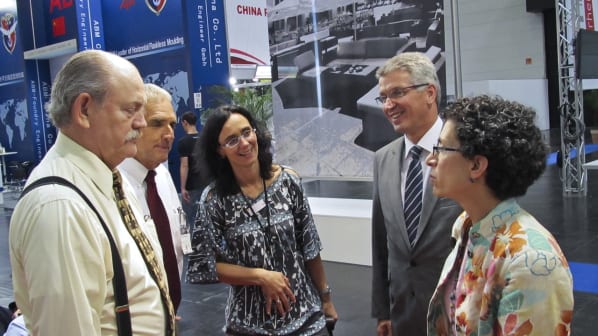
Schaumburg, Illinois (USA)-During the recent GIFA show in Duesseldorf, Germany, both Hunter Automated and its partner Maus reported successful exhibition of their machinery and related equipment.
Sandra Selwan, marketing manager for Maus (Padua, Italy), said the booth traffic was excellent throughout the show and that many current and potential customers visited. At the booth, Maus displayed its SAM multi-axis grinding system for gate and riser removal on metal castings. Owing to the offline programming station and rotating worktable, the SAM system from Maus enables cost-effective and high production rates. Also present at the booth were managing director Roberto Sammartin, sales manager Claudio Cossalter and the new North American sales manager, Carlo Canevese. Maus markets its machinery and related systems through Hunter Automated in North America and other select regions globally.
Meanwhile, at the Hunter (Schaumburg, Illinois-USA) booth, which was immediately adjacent to the Maus booth, activity was brisk throughout the event. Hundreds of metalcasters from dozens of countries around the world visited and, in several cases, consummated deals with Hunter, the global leader in matchplate molding systems and mold handling lines for green sand casting.
Working the booth were company president Bill Hunter, sales vp Kevin Purdy, sales manager Dean Martin and most of the global agent network Hunter, as well as representatives from the other manufacturing locations besides Chicago, namely, Brazil and China. As Purdy noted, “The strategy we’ve employed of manufacturing our machinery around the world, in key market areas for the foundry business, has proven both cost effective and customer-friendly.” Hunter also partners with Space’ and Versatile, all manufacturers of foundry equipment, in addition to Maus.
During the show, Hunter also inked deals for other representatives in the global foundry market. Details of these new arrangements will be forthcoming shortly, according to Hunter management.
Also a show highlight at the Hunter booth, they welcomed Ms. Janice Weiner, U.S. Consul General, along with Klaus Jonas, Communications Specialist for the U.S. Department of Commerce and representatives from the Messe Duesseldorf show management team, Eva Rowe and Ryan Klemm.
For more information, please contact:
HUNTER AUTOMATED MACHINERY CORPORATION
2222 Hammond Drive Schaumburg, IL 60196
Phone: (847) 397-5110
Fax: (847) 397-8254
Email: info@hunterfoundry.com
Attention: Bill Hunter, CEO
Web: www.hunterfoundry.com
Connect with Hunter Foundry online:
Hennig Opens New Facility for Power Generator Enclosure Systems
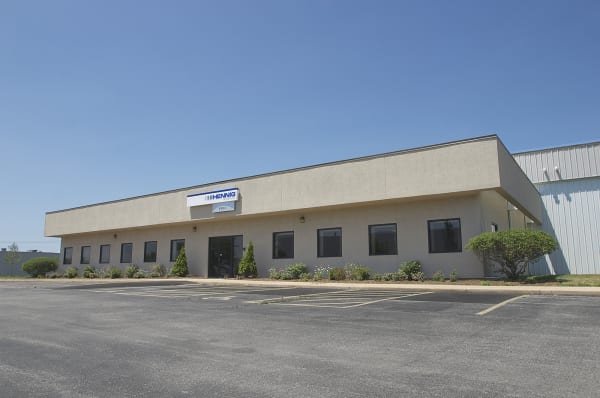

At this new location, Hennig Enclosure Systems will produce turnkey enclosures and fuel tanks for OEM power generator customers, as well as architects, design/build firms, contractors and consulting/engineering companies who constitute its current customer base. Customers interact with the company by utilizing the network of Hennig field sales engineers and service centers, as well as the recently developed online configurator software at the company’s website.

Local Rockford, IL contractor Cord Construction completed this new facility in less than six months from the date the previous facility was acquired by Hennig in November, 2010.
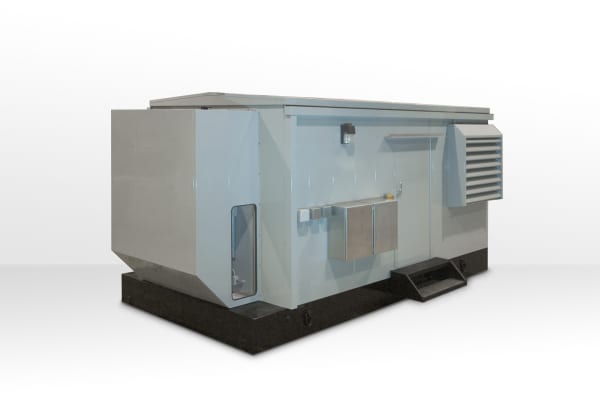
In addition to its work in the power generator market, Hennig, Inc. designs and produces custom machine protection and chip/coolant management products for state-of-the-art machine tools. Hennig products are designed to protect against corrosion, debris and common workplace contaminants. Manufacturing facilities are located in the U.S., Germany, France, Brazil, India, Japan, China and South Korea. Repair centers are located in Machesney Park, IL; Chandler, OK; Livonia, MI; Blue Ash, OH; Mexico City, Mexico; and Saltillo, Mexico.
To learn more about Hennig Enclosure Systems, visit www.hennig-enclosure-systems.com or contact:
Tim Waterman
Hennig Inc.
9900 N. Alpine Rd.
Machesney Park, IL 61115
(815) 316-5277
info@hennig.ame.com
www.hennigworldwide.com
—
Hennig, Inc. designs and produces custom machine protection and chip/coolant management products for state-of-the-art machine tools. Hennig products are designed to protect against corrosion, debris and common workplace contaminants. Manufacturing facilities located in the USA, Germany, France, Brazil, India, Japan, Czech Republic, England and South Korea. Repair centers are located in Machesney Park, IL; Chandler, OK; Livonia, MI; Blue Ash, OH; Mexico City, Mexico; and Saltillo, Mexico.
Continue reading
Manufacturing Summit Visits Dudek & Bock
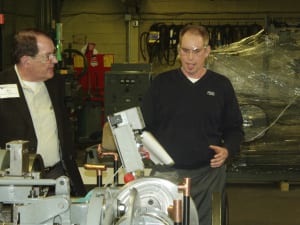

The presentation recapped the history of the company, from its humble beginnings in 1946, when Mike Dudek’s grandfather Joe and his partner Stan Bock started the business with two four-slide machines for springforming and a commitment to vertically integrated manufacturing, product quality and efficient operation of the factory that was and is the envy of the industry. Dudek & Bock today maintains over 500 machines for use at both plants, retrofitting and rebuilding them in their Chicago factory, plus the company produces over 90% of its own tooling to minimize reliance on outside sources and the attendant cost/delivery issues. Currently, the company produces over 1500 products to order.
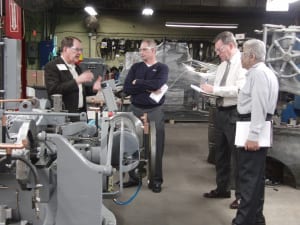
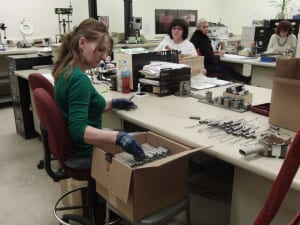
Complementing the core competencies of spring, wireform and light metal stamping production at Dudek & Bock, the company also maximizes its value to customers by providing a number of secondary operations on products, including all the following: welding, riveting, inline tapping and extrusion plus drilling, swedging, grinding, tapping, deburring, stress relief, shot peening, degreasing, some coating and oven curing, plus specialized packaging to suit customer requirements.
Raquel Chole noted that the employees from the Mexico plant, nearly all young and all well educated, are frequently brought to Chicago for machine cross-training and instruction on the protocols used by the company for production evaluation. “This policy gives the employees a great sense of belonging to our organization and company culture, plus they come away from the experience here with multiple skill sets that can be utilized at the Saltillo facility.”

Puz concluded the presentation with a detailed discussion on the “cost of quality” at Dudek & Bock. “We utilize world-class metrics to keep us a world-class company,” he said with no small amount of pride. “Quality has become part of our culture here and we review everything related to our machines, labor, overtime, earned hour ratio and more.” The result has been an outstanding 25% higher efficiency for man hours worked, over the last eight years, Puz noted.
Dudek & Bock is committed to a “design for manufacturability” strategy and utilizes an Advanced Production Quality Planning (APQP) process to make optimum use of the machinery and secondary operations in-house to produce products to specification and in the most efficient manner possible, Puz concluded.

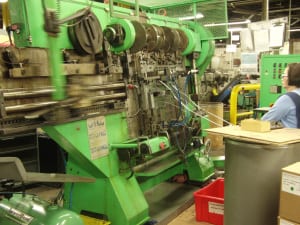
Eipe Varghese conducted the tour of his quality department, detailing how PPAP and segment checks are performed on all jobs at Dudek & Bock, sometimes in compliance with customer mandate, but more often to the stringent internal protocols established long ago by the company itself. “We perform load testing, full data capture and record keeping on all the work cells in the plant.” He noted the Mexico facility has a mirror image quality lab. “Gaging is often built in-house but we use external calibration services, as well, to be sure we’re on track at all times.”
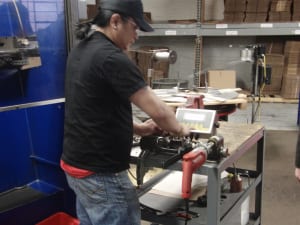
All in the group agreed this forward-thinking company was a fitting end to the Manufacturing Summit.
For video of this event, please visit: http://www.youtube.com/view_play_list?p=64D854D474995127
Agency contact: Tim Daro Bernard & Company 847-934-4500
Continue reading1200°F High Temperature Walk-in Oven

The oven has 10” thick insulated walls comprised of 2” of 1900°F block and 8” of 10 lb/cf density rockwool, an aluminized steel exterior and a Type 304, 2B finish stainless steel interior. A 12,500 CFM, 10-HP recirculating blower provides universal front to rear airflow to the unit.
The unit is also equipped with a 7” insulated floor with truck wheel guide tracks and a flatbed loading truck with a 5000 lb capacity. The external frame works with lifting eyes to allow this 18,000 lb oven to be moved by crane. It also features inner and outer gaskets; the inner gasket seals directly against the door plug and the outer gasket seals directly against the front face of the oven.
Controls onboard No. 905 include a digital programming temperature controller, free standing remote control panel, manual reset excess temperature controller with separate contactors, SCR power controller, strip chart recorder and recirculating blower airflow safety switch.
For more information, please contact: THE GRIEVE CORPORATION, 500 Hart
Road, Round Lake, Illinois 60073-2835 USA. Phone: (847) 546-8225. Fax: (847) 546-9210. Web: www.grievecorp.com. Email: sales@grievecorp.com. Attention: Frank Calabrese.
Agency Contact: Tim Daro: 847-934-4500
Continue readingMAGMA: PREMIER ALUMINUM ANNOUNCES VIRTUAL TECHNOLOGY CENTER
Wisconsin foundry prospering from its use of technology, including MAGMASOFT® simulation software for metalcasting
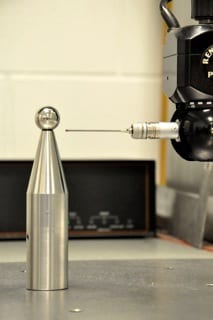
Premier has invested in all necessary tools and facilities to enable full collaborative engineering with its customers. Its current goal is to achieve the desired casting quality by further reducing costs and decreasing time to market for its customers. This progressive approach to working with customers by utilizing advanced technical tools in an R&D facility will now be referenced as the Technology Center at Premier Aluminum.
The Technology Center will now be available to any Premier customer or potential customer who wishes to work closely with the Premier Engineering Team to quickly and accurately develop new products or re-engineer already existing ones. Its engineering team boasts 50+ years experience in metalcasting, plus the latest advancements in the aluminum foundry industry. To better serve its customers, Premier employs such advanced software as Solidworks, MAGMASOFT® and other engineering tools to enhance customer confidence in tool life, product quality and efficient manufacturing processes, through a more predictive and trackable engineering protocol.
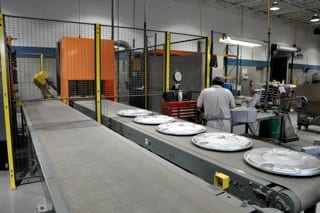
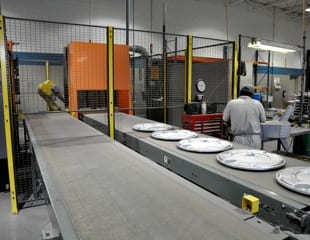

For more information on this announcement, please contact:
Kevin Kelly – Sales Manager PREMIER ALUMINUM 3633 S. Memorial Dr. Racine, WI 53403 Phone: 262-554-2100, Ext. 130 Email: kevin.kelly@premieraluminum.com Web: www.premieraluminum.com
OR
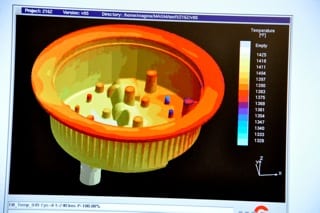
10 N. Martingale Road, Suite 425 Schaumburg, IL 60173 Phone 847-969-1001, ext. 223
Email: ssikorski@magmasoft.com Web:www.magmasoft.com
Agency contact: Tim Daro Bernard & Company 847-934-4500 tdaro@bernardandcompany.com
Continue readingSIGMA: SPE GGS June Lunch Seminar Webinar
SPE GGS June Lunch Seminar Webinar

Seminar Abstract
In-depth injection molding simulation software has typically been used by analysts who have the expertise to setup the complex mesh model required for simulation. With advanced simulation technology from SIGMA, injection molding simulation is easier to use and more accurate than ever. This opens the door to product designers, project managers, and engineers in charge of polymer injection molds and processes, as well as analysis groups. Companies no longer need to rely on a “meshing expert” to employ injection molding simulation.
The presentation will highlight the power of injection molding simulation when considering 3D mold components, cooling channels, the complete runner system, and part geometries coupled with multi-cycle analysis. Simulation is a must-have tool for companies wanting to evaluate ‘what if’ scenarios of the entire injection molding process early in the design and tooling stages.
Seminar/Webinar Information
Where: Exponent, Inc. 149 Commonwelath Drive, Menlo Park, CA
When: Thursday, June 30, 2011, 11:30 AM – 1:00 PM (lunch provided to those attending the seminar)
Cost: Lunch: $20 non-members, $15 members, $10 students/unemployed/retired – cash at door or via Paypal
Cost: Webinar: $10 – Paypal only. WebEx invitation will be sent upon receipt of payment
RSVP: Jennifer Hoffman at jhoffman@exponent.com; RSVP by noon, Tuesday, June 28th.
